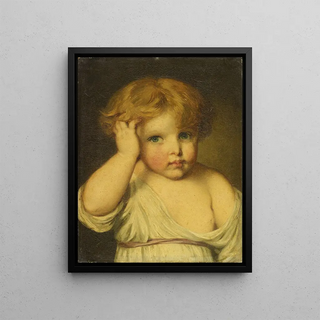Art print | Portrait of a Child - Jean-Baptiste Greuze Source: Reproduction | Portrait d'un enfant - Jean-Baptiste Greuze


View from behind

Frame (optional)
Portrait of a Child - Jean-Baptiste Greuze – Captivating Introduction
In the rich and nuanced universe of art history, certain works stand out for their ability to capture innocence and childhood beauty. The "Portrait of a Child" by Jean-Baptiste Greuze is a shining example. This piece, created in the 18th century, not only demonstrates the artist's unparalleled talent but also reflects an era when art mirrored human emotions. Through this portrait, Greuze invites us to delve into the intimacy of a young face, explore the subtleties of expression, and feel the tenderness emanating from this depiction. The work, imbued with delicacy, does not merely freeze a moment; it evokes a story, sensitivity, and a deep connection between the artist and his model.
Style and uniqueness of the work
Greuze's style is characterized by a naturalistic approach, where light and shadow play a leading role in highlighting the subject's features. In the "Portrait of a Child," every detail is carefully crafted, from the sparkling curiosity in the eyes to the delicately blushed cheeks. The color palette, soft and harmonious, helps create a warm, almost intimate atmosphere. The artist employs chiaroscuro techniques to accentuate volumes and bring his model to life, making the scene even more captivating. This portrait also stands out for its expressiveness; the child's gaze, both innocent and full of promise, touches and engages us. Greuze manages to transcend the simple exercise of representation to offer us a true emotional experience.
The artist and his influence
Jean-Baptiste Greuze, an emblematic figure of the Rococo movement, left a mark on his era through his artistic sensitivity and his ability to portray human emotions so poignantly. Trained in the workshop of Charles Le Brun, Greuze quickly developed a distinctive style, combining realism and idealization. Although influenced by the masters of classical painting, his unique approach allowed him to stand out. His works, often focused on scenes of daily life and portraits, had a significant impact on his contemporaries

Matte finish

View from behind

Frame (optional)
Portrait of a Child - Jean-Baptiste Greuze – Captivating Introduction
In the rich and nuanced universe of art history, certain works stand out for their ability to capture innocence and childhood beauty. The "Portrait of a Child" by Jean-Baptiste Greuze is a shining example. This piece, created in the 18th century, not only demonstrates the artist's unparalleled talent but also reflects an era when art mirrored human emotions. Through this portrait, Greuze invites us to delve into the intimacy of a young face, explore the subtleties of expression, and feel the tenderness emanating from this depiction. The work, imbued with delicacy, does not merely freeze a moment; it evokes a story, sensitivity, and a deep connection between the artist and his model.
Style and uniqueness of the work
Greuze's style is characterized by a naturalistic approach, where light and shadow play a leading role in highlighting the subject's features. In the "Portrait of a Child," every detail is carefully crafted, from the sparkling curiosity in the eyes to the delicately blushed cheeks. The color palette, soft and harmonious, helps create a warm, almost intimate atmosphere. The artist employs chiaroscuro techniques to accentuate volumes and bring his model to life, making the scene even more captivating. This portrait also stands out for its expressiveness; the child's gaze, both innocent and full of promise, touches and engages us. Greuze manages to transcend the simple exercise of representation to offer us a true emotional experience.
The artist and his influence
Jean-Baptiste Greuze, an emblematic figure of the Rococo movement, left a mark on his era through his artistic sensitivity and his ability to portray human emotions so poignantly. Trained in the workshop of Charles Le Brun, Greuze quickly developed a distinctive style, combining realism and idealization. Although influenced by the masters of classical painting, his unique approach allowed him to stand out. His works, often focused on scenes of daily life and portraits, had a significant impact on his contemporaries






